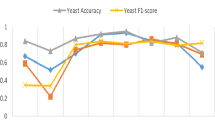Abstract
In practice, there are many binary classification problems, such as credit risk assessment, medical testing for determining if a patient has a certain disease or not, etc. However, different problems have different characteristics that may lead to different difficulties of the problem. One important characteristic is the degree of imbalance of two classes in data sets. For data sets with different degrees of imbalance, are the commonly used binary classification methods still feasible? In this study, various binary classification models, including traditional statistical methods and newly emerged methods from artificial intelligence, such as linear regression, discriminant analysis, decision tree, neural network, support vector machines, etc., are reviewed, and their performance in terms of the measure of classification accuracy and area under Receiver Operating Characteristic (ROC) curve are tested and compared on fourteen data sets with different imbalance degrees. The results help to select the appropriate methods for problems with different degrees of imbalance.
Similar content being viewed by others
References
Japkowicz N. Learning from imbalanced data sets: a comparison of various strategies. In: Proceedings of the AAAIWorkshop on learning from imbalanced data sets. Tech. rep. WS-00-05, Menlo Park, CA: AAAI Press, 2000
Nitesh V C, Nathalie J, Aleksander K. Editorial: special issue on learning from imbalanced data sets. In: Proceedings of the ACM Special Interest Group on Knowledge Discovery and Data Mining Explorations, Newsletter, 2004, 6(1): 1–63
Baesens B, Gestel T V, Viaene S, et al. Benchmarking state-of-the-art classification algorithms for credit scoring. Journal of the Operational Research Society, 2003, 54(6): 627–635
Bishop C M. Pattern Recognition and Machine Learning, New York: Springer, 2006
Rosenberg E, Gleit A. Quantitative methods in credit management: a survey. Operations research, 42(4): 589–613
Zhou L G. A study on credit scoring with support vector machines, PhD thesis, City University of Hong Kong, 2008
Quinlan J R. Induction of Decision Trees. Machine Learning, 1986, 1(1): 81–106
Quinlan J R. C4.5: Programs for Machine Learning, Los Altos: Morgan Kaufmann, 1993
Breiman L, Friedman J, Olshen R, et al. Classification and Regression Trees, Wadsworth Statistics/Probability Series Belmont, CA: Wadsworth, 1980
Maimon O, Rokach L. Data Mining and Knowledge Discovery Handbook, New York: Springer, 2005
Gurney K. An Introduction to Neural Networks, London: UCL Press, 1997
Donald F S. Probabilistic neural networks, Neural Networks, 1990, 3(1): 109–118
Demuth H, Beale M, Hagan M. Neural Network Toolbox 6 User’s Guide, Mathworks, 2008
Vapnik, V N. Statistical Learning Theory. New York: Springer-Verlag, 1998
Suykens J A K, Gestel T V, Brabanter J D, et al. Least Squares Support Vector Machines, Singapore: Singapore World Scientific Pub. Co., 2002
Lai K K, Yu L, Zhou L, et al. Credit risk evaluation with least square support vector machine, Lecture Notes in Computer Sciences, 4062: 490–495, 2006
Zhou L, Lai K K, Yu L. Credit scoring using support vector machines with direct search for parameters selection. Soft Computing - A Fusion of Foundations, Methodologies and Applications, 13(2): 149–155, 2009
Freund Y, Robert E S. A short introduction to boosting. Journal of Japanese Society for Artificial Intelligence, 1999, 14(5): 771–780
Rakotomamonjy A. Optimizing area under ROC curve with SVMs. In: Proceedings of the Workshop on ROC Analysis in Artificial Intelligence, 2004
Fawcett T. An introduction to ROC analysis. Pattern Recognition Letters, 2006, 27(8): 861–874
Vezhnevets A, Vezhnevets V. Modest AdaBoost - Teaching AdaBoost to Generalize Better. In: Proceedings of the Graphicon-2005. Novosibirsk Akademgorodok, Russia, 2005
Author information
Authors and Affiliations
Corresponding author
Rights and permissions
About this article
Cite this article
Zhou, L., Lai, K.K. Benchmarking binary classification models on data sets with different degrees of imbalance. Front. Comput. Sci. China 3, 205–216 (2009). https://doi.org/10.1007/s11704-009-0027-1
Received:
Accepted:
Published:
Issue Date:
DOI: https://doi.org/10.1007/s11704-009-0027-1




